Text
🌟 🎧 Celestial Astral Travel Sound Resources 🌟 🎧

thought i’d share with you the sound generator prefixes i use when practicing astral travel involving the planets of our system, among other celestials
⊙ Sun ☾ Moon ☿ Mercury ♀ Venus ⊕ Earth ♂ Mars ♃ Jupiter ♄ Saturn ♅ Uranus ♆ Neptune ♇ Pluto
🌌Nebula ✨Meteor 💫Solar Wind 🌐The Void / Vaccum ⚫Black Hole ⭐ Asteroid 🌠 Comet 🌟Star Cluster 💥 Supernova 🚀 Interstellar Dust 🔭 Aurora
Just go ahead now and take three deep breaths. You are about to undergo a fantastic voyage both deep inside yourself and far into the reaches of the Solar System.
2K notes
·
View notes
Text
Sky Witchcraft ⭐️☁️🌅
This is a general guide to my particular path!
There are three basic components: air, water, and cosmic witchcraft!
Air☁️: wind and clouds! Ground using the wind or practice divination with the clouds. Also good for sigil work. Associated with the colors yellow and light blue, swords and other blades, clarity, and education. Dawn and springtime are good times to work with this element!
Water💧: rain, mist, and clouds! Gather rain or try making moon/sun/storm waters. Associated with blue, mirrors, cups, emotion, and healing. Sunset and autumn are this element’s associated times.
Cosmic💫: sun, moon, and stars! Perfect for stargazing and charging stones or sigils with the sun or moon! Associated with black, indigo, silver, gold, fate, and wisdom. The best times for this are year-round at night- special events like meteor showers or eclipses can be very helpful!
The types of divination that go well with it are cartomancy, astrology, and aeromancy (divination by clouds/weather phenomena)! Thanks for reading! 🌟🌅
125 notes
·
View notes
Text
Everyday Magic for the Cosmic Witch

Here are some cosmic and celestial things you can work into your everyday life to make it a little more magical. You do not need to be a cosmic witch to practice these!
Wear clothing and accessories with symbols of space and the stars. Allow your appearance to remind yourself and everyone of your connection to the cosmos.
Use a galaxy bath bomb. There are many shops online that sell glittery bath bombs that make your tub look like the night sky.
Decorate your room with fairy lights. Let the small dots of light remind you of the stars even when you are indoors.
Check your horoscope every day. Turn to the stars for guidance.
Put your bed near a window so at night you can gaze at the stars and the moon.
Notice when the moon is out during the day and remember that she is surrounded by stars even if you cannot see them.
Wear blue goldstone jewelry or keep a blue goldstone in your pocket to remind you of the stars.
Decorate your altar with stars. You can use beads or charms or little bottles of glitter.
Study the constellations during the day and see if you can find them at night. Keep up to date on what constellations are visible at the current time of year.
Keep notes on the moon phases and how they affect your day. You might notice you have more energy on full moons or you feel more anxious when it is waning. See how you are connected with the moon.
Make moon water nightly and drink it in the morning to prepare yourself for the day.
Buy moon shaped crystals and use them for your altar or for meditation.
Meditate with selenite to connect to the moon and access your higher self.
Use labradorite for warding and protection. It is a crystal that can harness the energy of the moon to protect you and your home.
To purify things using lunar energy, use opal. Place an opal next to your water at night to make it moon water. Opalite is a cheaper alternative but know that it is a manmade stone.
399 notes
·
View notes
Text
energy study: storm energy
appearance and feel
- very potent and very dynamic, almost like a dynamo but not shifty or unstable
- has a hummy and charged feel to it because of electricity from lightning
- will take on a more rumbly and heavier feel in the presence of thunder, and a more jittery and dynamic feel in the presence of lightning
- has a heavier and more up-and-go feel than rain energy, but should be very compatible with rain energy
energetical qualities
- quite powerful in terms of both offence and defence
- has a weight to it, but is not constricting
- can be stable and grounding but also unpredictable and tempestual
- very concentrated but not suffocating
- not very flexible or malleable
- must be given a push in order to cover more distance in a shorter amount of time, if not it’ll just spread slowly
- quite accessible depending on your geographical location
energetical components
- a lot of water and air (air especially when strong winds are present)
- electricity in the presence of lightning
compatibilities
- plant energies: very compatible with plant energies, because rain gives life
- night or darker energies: mixes well to a certain extent
- lunar energies: compatible with lunar energy, especially from a storm at night
- ocean and sea energies: compatible, weather and the sea have a connection
energetical uses
- great source to power your wards
- works very well in terms of powering emotionally-charged spells involving bindings and hexes and curses, and especially something that needs a heavier touch
- generally great with weather spells or rain-calling
- if you find an affinity for storm energy you might find it a very handy one for grounding
307 notes
·
View notes
Text
Example Modernisation of an Ancient Greek Festival
For times when you want to go all-out and make a fuss! Festivals were exciting events and a celebration of the people and their gods.
Firstly, dress up! This is a fun event, a party even, so try wearing something that gets you in the mood or mindset. Traditionally people would wash or at least wash their hands beforehand for purification.
Light a candle and/or incense and call your god/s. Say a prayer or hymn, or just tell them how great they are and that you want to share in this festival with them. Traditional actions also include a procession toward the sacred space, scattering barley (likely for purification) and making an offering/sacrifice
Festivals were held for a multitude of reasons and featured many different ways to honour the deity or event happening that day. Below are some examples and how you could celebrate in that way, alone or with others.
Imagery
Statues - dress the statue, decorate with necklaces, garlands, flower crowns, or anoint with water/oils
painting/picture/drawing - place flowers around it/hanging from the frame, anoint with water/oils
shrine/altar space - decorate however you see fit. Crystals, flowers, images, random bits and bobs, etc. Wreaths, flowers, offerings, items/imagery/colours sacred to the deity
Contests
backyard sports
card games
board games
video games
arm wrestling
races
Plays and Performances
tv shows/movies
plays
stand up comedy
playing an instrument
read poetry aloud
sing (along with the radio!)
dancing (the shuffle with your dog totally counts)
create a playlist/s
Feast
fruit
meat/s
vegetables
cheese, dips and crackers
bread (especially object-shaped bread *cough phallus cough*)
drinks (alcoholic or not)
soups/stews/porridge
set aside a plate for the deity (called theoxenia)
Seasonal
seasonal fruits and vegetables
new wine/alcohol
celebrating/saying thanks for the warmth of summer
warding off the cold of winter
praying for a good harvest
praying for the prosperity and wealth of the family/household/city
rememberance
These are not every day activities and do not have to be enacted for every festival. But if a bit of fun and partying sounds like a good idea, go for it!
270 notes
·
View notes
Text
Attempting to set up a "holiday decoration" box
One of the things that make holidays feel like holidays is symbolic decor. There's a reason why, when December comes around, people get excited about shiny garlands, gingerbread cookies and branches of holy/mistletoe. If you take those elements apart, they don't really mean much but once in context, they communicate a particular message linked to a particular tradition. While I've taken a Christian example, the association of symbolism to specific religious event is something that is found across cultures and faiths.
For hellenic reconstructionists, the question of "what do the festivals mean and how did people celebrate?" is very real, especially when the information is fragmentary and doesn't do justice to the religious diversity of the Ancient World.
the Eiresione: the eiresione is a branch of olive or laurel that is adorned with wool, dried fruits, nuts, sometimes little flasks of oil or honey. I'm putting it first because there's a lot to cover. It's part of at least the Pyanepsia, but some people associate it with both the Pyanepsia and the Thargelia, and I would even be tempted to add the Delphinia. The pattern is that those are all festivals to Apollo.
Plutarch, in his Life of Theseus (22), gives us more details:
At that feast they also carry the so-called ‘eiresione,’ which is a bough of olive wreathed with wool, such as Theseus used at the time of his supplication, and laden with all sorts of fruit-offerings, to signify that scarcity was at an end, and as they go they sing:—
"Eiresione for us brings figs and bread of the richest, brings us honey in pots and oil to rub off from the body, Strong wine too in a beaker, that one may go to bed mellow."
The part in bold is what leads me to believe there might be a link with the Delphinia, even if they don't have the same ritual purpose, as Plutarch also describes earlier in Life of Theseus (18.1):
When the lot was cast, Theseus took those upon whom it fell from the prytaneium and went to the Delphinium, where he dedicated to Apollo in their behalf his suppliant's badge. This was a bough from the sacred olive-tree, wreathed with white wool. Having made his vows and prayers, he went down to the sea on the sixth day of the month Munychion, on which day even now the Athenians still send their maidens to the Delphinium to propitiate the god.
In the ritual for the Pyanopsia, the eiresione would be carried by a young boy during the procession to the temple of Apollo, where it would be placed at the door. That being said, there's indication that people had their own eiresione at home, close to their house door:
several passages of Aristophanes which show that any normal house in Athens might be expected to have one outside the front door all year round; [...] The orator Lycurgus associates the origin of the custom with an ancient famine, and says ‘decorating a large olive branch with everything that the seasons produce at that time they dedicated it to Apollo in front of their doors, calling it eiresione, making first fruit offerings of all the products of the earth, because the suppliant branch placed with Apollo ended the famine in our land.’
-Robert Parker, Polytheism and Society at Athens, 2005
We could go on and on with this topic, but the point is just that the eiresione is meant to be a bringer of wealth to the household. Its purpose and use in religious festival make it an item to consider when thinking about stuff to add to your religious paraphernalia.
Garlands: They are mentioned in sources and probably could exist both made out of flowers and fabric but we don't really know what they actually looked like. This seems like a generally versatile festival decoration. Colour-coding could be an interesting modern adaptation.
Wreaths: following with the garland logic, this is something that seems very universal and could easily be adapted to the time of the year/festival. Olive wreaths for important Athena festivals, laurel for Apollo, vine for Dionysus, wheat for Demeter etc. Wreaths could make up for a very rich and handy way of decorating for specific festivals.
Phallus and phallic imagery: Again, a symbol that comes up in processions, especially for Dionysus. I'm aware this isn't the easiest to pull off, but if 1) you're fine with the imagery and 2) have the freedom to decorate your house however you want, this is something to consider for Dionysian and Demeter festivities.
Torches, fire imagery/candles: Fire is a bit of a given considering the central place of the hearth in this religion, but I wanted to bring it up for some specific events. The Prometheia, the Panathenieia and the Hephaisteia all included a torch race. The Mounychia also featured "little torches" (dadia) that were put on the cake-offerings to Artemis (the amphiphontes).
Cow and bull imagery: Appropriate for Zeus and Hera-centered festivals, especially the Dipolieia.
Bear imagery: Especially appropriate for the Brauronia.
This is a work in progress, and I will probably update those ideas in the future. It's while making the holiday cards that I realized what was missing was clear symbolism for the festivals that are part of my religious calendar. Feedback and ideas more than welcome.
141 notes
·
View notes
Photo
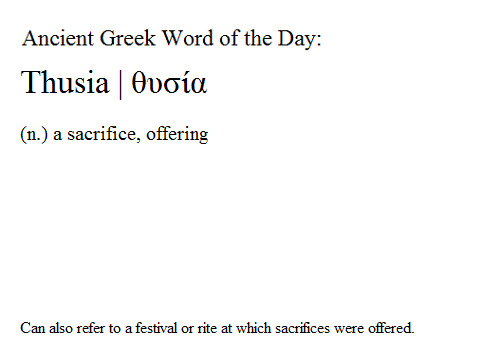
Sacrifices were an important part of life in ancient Greece, not just because of the religious connotations, but because for many, it was the only time one had the chance to eat meat. Although fish was a staple of the Greek diet, and smaller communities could hunt small game, having red meat was extremely rare for any, even the rich.
Sacrifices were modeled as being for the gods; however, the gods got a very small portion of the meat of the animal sacrificed, the rest often going to the people who showed up to the festival, rite, or other occasion for the sacrifice.
This practice began, they said, when Prometheus tricked the gods into taking a portion of meat that was only thigh bones wrapped in fat with a bit of meat upon them. After this, Athenians copied this as tradition, and the rest of the meat of the animal(s) sacrificed was distributed according to the custom of the particular occasion.
However, this was not the procedure followed for all sacrifices. For example, when sacrificing to Hades, a burnt offering was usually placed in the ground, burned completely, and left for the god of the underworld. This was called a holocaust.
31 notes
·
View notes
Text
Dissecting the Anatomy of Prayer
Within Hellenic polytheism, prayers in supplication or thanksgiving typically contain elements of a recognisable formula, the purpose of which is to gain the attention of a god/s most appropriate to your request or words of thanks with justification or explanation for the prayer:
Greeting and call to god/s
Naming epithets/cult titles and favoured shrines or places
Invocation of kharis
Request or thanksgiving
Farewell
Constructing prayers within this framework can be as elaborate or simple as your need requires. The greater the need the longer and more flattering the prayer.
But how to recognise this formula in traditional prayers in order to construct one of your own? I’ve outlined a few examples and colour-coordinated the key points to match the formula above.
Ready for some colour vomit? Let’s go …
Hear me, you of the silver bow, you who stand in protection over Chryse and holy Killa, and who rule Tenedos with your might, Smintheus, if ever I placed a roof on your lovely temple, or if ever I burned for you the fat thighs of bulls or of goats, grant me this request: let the Danaans pay for my tears with your arrows. Iliad 1.37-42
Now, queen of the land of sweet Eleusis and sea-girt Paros and rocky Antron, lady, giver of good gifts, bringer of seasons, queen Deo, be gracious, you and your daughter all beauteous Persephone, and for my song grant me heart-cheering substance. And now I will remember you and another song also. Homeric Hymn to Demeter
Zeus, thou king, Dodonaean, Pelasgian, thou that dwellest afar, ruling over wintry Dodona,—and about thee dwell the Selli, thine interpreters, men with unwashen feet that couch on the ground. Aforetime verily thou didst hear my word, when I prayed: me thou didst honour, and didst mightily smite the host of the Achaeans; even so now also fulfill thou for me this my desire. Myself verily will I abide in the gathering of the ships, but my comrade am I sending forth amid the host of the Myrmidons to war: with him do thou send forth glory, O Zeus, whose voice is borne afar, and make bold the heart in his breast, to the end that Hector, too, may know whether even alone my squire hath skill to fight, or whether his hands then only rage invincible, whenso I enter the turmoil of Ares. But when away from the ships he hath driven war and the din of war, thea all-unscathed let him come back to the swift ships with all his arms, and his comrades that fight in close combat. Iliad 16.233-248
Deathless Aphrodite of the spangled mind, child of Zeus, who twists lures, I beg you do not break with hard pains, O lady, my heart, but come here if ever before you caught my voice far off and listening left your father’s golden house and came, yoking your car. Sappho Ode to Aphrodite
Kindly Zeus, Ombrios, bringer of rain, and you Maimaktes who clouded over, I thank you for the life-bringing rains and the warm moist air that my plants love. But I thank you most of all for protecting my home from your damaging winds and the strike of thunder. May you always grant me shelter and fertile soils. Prayer to Zeus after a summer storm
387 notes
·
View notes
Text
Organizing worship
I wasn't sure I wanted to post about this but maybe it can inspire others.
Several months ago when I decided to completely change my worship with a new calendar, a new set of festivals, and overall a ton of new things, it became more and more obvious to me that having all the information I needed for celebrations only in digital format was not going to do it.
Having to twist my neck to look at my laptop or phone screen when I couldn't remember hymns from the top of my head was already something I found to be a small inconvenience and made me prefer to have physical copies of the hymns. Only, that doesn't work anymore when half of the hymns you need to recite are your own.
So I had two choices, start a notebook or put something together. Since I can't reread my own handwriting for the life of me, I went with option number 2, made a book for my own use, and had it printed on command.
I'm very happy with the result, and I'm glad to share how it looks, but mostly, if there's any value in me sharing this, it's to explain how it's organized.


The first section is reserved for all the festivals. My calendar has 26 of them scattered throughout the year. For each of them, this is the information I included:
Date: since I follow the lunar calendar, I only included the date in the Greek format. This way the book doesn't give erroneous dates in the years to come. I track the days through my digital calendar anyway.
Gods and relevant epithets for the festival
A short summary of what the festival is about: this is both to have a reminder but also to keep track of the modernizations I have made and based on what historical ground.
List of offerings and libations
Hymn(s) recited/sung: some are Homeric, others are ones written by myself.
Recipe for the main offering/feast

The second, and much smaller section served to finally put together all the hymns needed for the monthly observances and the various other smaller sacred days included in my calendar that are not full-blown festivals. The layout is very similar for them, except that they do not have recipes linked to them.
It's so much more convenient than waking up your phone screen every 20 seconds, but the other benefit I've found is that putting this together really forces you to look at the blind spots in your worship and take care of them.
If there's something to take away from this rambly post is simply that putting things down on paper somehow really really helps. Or at least, it helped me immensely in having a sense of knowing what the hell I'm doing.
159 notes
·
View notes
Text
Khernips soap
So I had some left over pumped breast milk. My toddler barely breastfeed anymore and I have no use for the pumped milk bags, it's just wasting there in the fridge.
I read somewhere you can make soap out of it, because it's very good for your skin. And I thought, hey, I also could make it as a nice offering for Ares, that I consider in my UPG to be an enthusiastic breastfeeding supporter.
I melted some soap chips I bought, poured the breast milk in it, added tons of dried herbs from a tea box I have, and froze it.
It smells amazing, and I decided to use it as a khernips soap to wash my hands with before rituals!
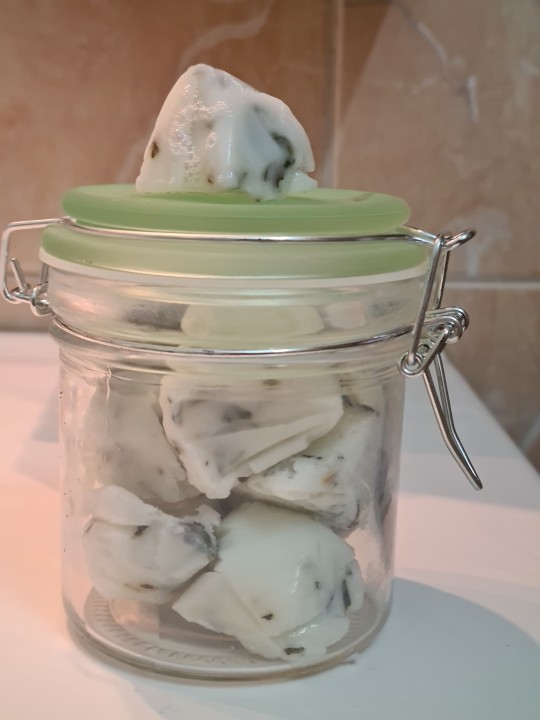
9 notes
·
View notes
Text
Masterpost of Resources for Hellenic Polytheism
I made a masterpost in April, and updated it again today… and then I realized it was in desperate need of organization. Instead of separating my resources from everyone else’s, because that honestly doesn’t do anything, this is a more organized version with mine mixed in, too. Let me know if you find any good resources you think I should add to this list!
Khaire, everyone!
Household Worship & Getting Started
Basic Supplies for Hellenic Polytheism - @breathing-in-gilded-dust
Building Your Worship - @pomegranateandivy
Sacredness of a Home - @baringtheaegis
Household Gods - @hearthfirehandworks
Getting Into Hellenismos (Dorms) - @baringtheaegis
Rituals, Offerings, and Prayers/Praise
Why You Should (Probably) Eat That Offering - @songbirdspells
Note on ‘Proper’ Offerings - @poemsandmyths
How to Pray to, Praise, and Worship the Theoi - @breathing-in-gilded-dust
Tips for Worshiping the Theoi When You Are Non-Verbal - @breathing-in-gilded-dust
(Modernized) Ancient Ouranic Offering Ritual - @breathing-in-gilded-dust
(Modernized) Nekromanteion Ritual - @breathing-in-gilded-dust
Why You Should (Probably) Eat That Offering - @songbirdspells
Note on ‘Proper’ Offerings - @poemsandmyths
Why Worship a God of War? - @honorthegods
Communication With the Theoi, and Why It’s Okay to Not Receive Signs/Messages - @pomegranateandivy
Offering DIY: How to Make Recycled Paper - @breathing-in-gilded-dust
Recipes for the main 13 (part one) // (part two) - @breathing-in-gilded-dust
Recipes for Other Theoi (part one) - @breathing-in-gilded-dust
Epithets of The Theoi
My Personal Unique Epithets for the Theoi - @breathing-in-gilded-dust
My Personal Epithets for Persephone - @breathing-in-gilded-dust
My Personal Epithets for Haides - @breathing-in-gilded-dust
Epithets and Titles of Aphrodite - Theoi.com
Epithets and Titles of Apollon - Theoi.com
Epithets and Titles of Ares - Theoi.com
Epithets and Titles of Artemis - Theoi.com
Epithets and Titles of Asklepios - Theoi.com
Epithets and Titles of Athena - Theoi.com
Epithets and Titles of Demeter - Theoi.com
Epithets and Titles of Dionysos - Theoi.com
Epithets and Titles of Haides - Theoi.com
Epithets and Titles of Hekate - Theoi.com
Epithets and Titles of Hephaistos - Theoi.com
Epithets and Titles of Hera - Theoi.com
Epithets and Titles of Hermes - Theoi.com
Epithets and Titles of Hestia - Theoi.com
Epithets and Titles of Persephone (mainly worshiped alongside Demeter) - Theio.com
Epithets and Titles of Poseidon - Theoi.com
Epithets and Titles of Selene - Theoi.com
Epithets and Titles of Zeus - Theoi.com
Lyma & Miasma
The Debate on Daily Purification and the Difference Between Miasma and Lyma - @sisterofiris
A Follow Up on Pollution and Purification - @sisterofiris
How we Pick Up Lyma and a Note on Binding/Veiling - @sisterofiris
Festivals
Hellenic Revivalist Calendar - @pomegranateandivy
Hellenic Polytheism Festivals and Information - @pomegranateandivy
Hellenion.org (Site for reconstruction of the Hellenic Polytheistic religion with festival calendars, ritual ideas, and more… highly recommended)
Link to their 2019 calendar page
Link to their festival directory
Elaion.org (Another group for Hellenic Polytheists with rituals, festival calendars, etc. Very wonderful as well)
Link to their 2019 calendar page
Link to their Resource Page
Arete and Other Values
Hellenic Polytheism and Depression - @breathing-in-gilded-dust
The Pillars of Hellenismos - @honorthegods
Veiling
Amaranta’s Guide to Basic Hair Binding and Veiling - @breathing-in-gilded-dust
Hellenic Veiling - @pomegranateandivy
Books, Academic Posts, and Other Resource Masterposts
Tons of Great Books for Hellenic Polytheists (with free PDFs) - @breathing-in-gilded-dust
Hellenic FAQ - @pomegranateandivy
Magic in Ancient Greece and Rome - @bayoread
Harvard’s Center for Hellenic Studies - @songbirdspells
Recommended Books About Hekate - @teawitch & @the-witching-tree
Information and Tips About Persephone’s Worship (And some for Aphrodite as well) - @honorthegods
Free Academic Resources Masterpost - @secondgenerationimmigrant
Site for Learning Ancient Languages - @witchofeindor
Information About Hekate - @baringtheaegis
Theoi.com (a site full of information about all of the gods and goddesses that we really know about. Good for basic information. Not the end-all-be-all, and as with any site, can sometimes be inaccurate, though usually great for beginner things, epithets, etc.)
The Monster Compilation of Free Online Resources for Classical Studies - @honorthegods
Ancient Greek Mountain Cultus - @sisterofiris
baringtheaegis.blogspot.com (This a wonderful, wonderful blog) - @baringtheaegis
Two Book Recommendations with Free PDFs - @nessotropheion
Great Sites for Research - @pomegranateandivy
The Greek Alphabet Oracle (similar to Nordic rune-casting) - Apollonius Sophistes
Hymns/Prayers Masterposts
My Hymns, Prayers, and Poetry (WIP) - @breathing-in-gilded-dust
Prayers and Devotionals - @pomegranateandivy
Blogs I recommend:
@pomegranateandivy
@honorthegods
@sisterofiris
@songbirdspells
@baringtheaegis
@thepastelpriestess
4K notes
·
View notes
Photo






Here are some offering recipe inclusion ideas for some other Theoi! Feel free to requests ones that I haven’t yet created. Check these two posts first, though!
Part One
Part Two
And Here’s one for how to make the paper itself!
Included are:
Nymphai
Hekate
The Mousai
Haides
Persephone
Nyx
31 notes
·
View notes
Photo

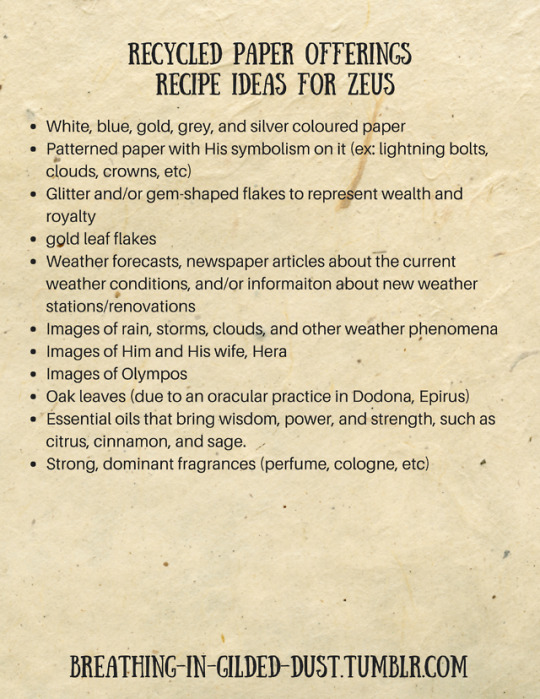
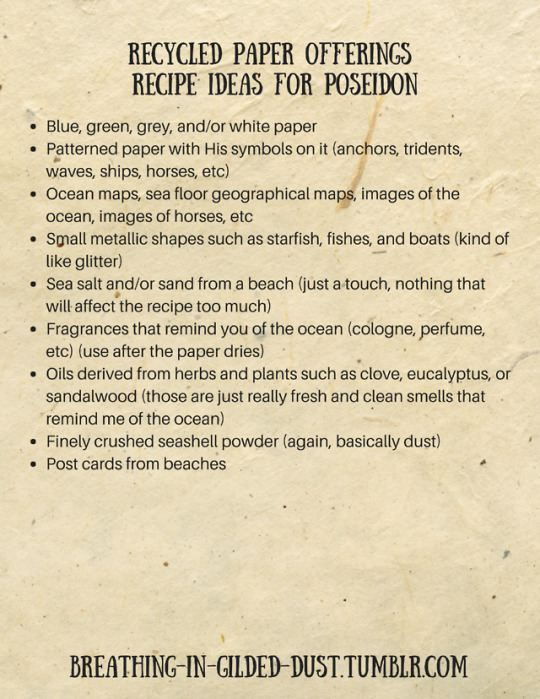
And the second half of my recycled paper offering recipe ideas is finally here <3
Took ya long enough, Tumblr!
Here is who is on this set:
Hestia
Poseidon
Zeus
I am making more of these, so if you don’t see the one you’re looking for, just wait! They are on their way! Some I am making are:
Hekate
Haides
Persephone
Nyx
The Nine Muses
Nymphai
54 notes
·
View notes
Photo

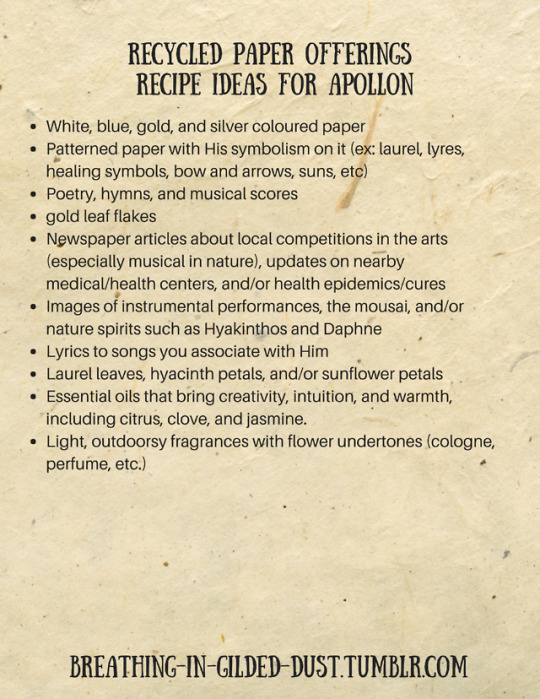

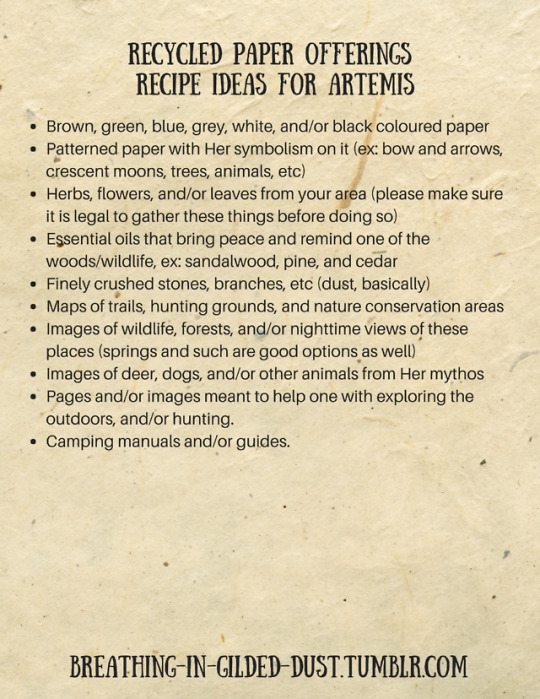

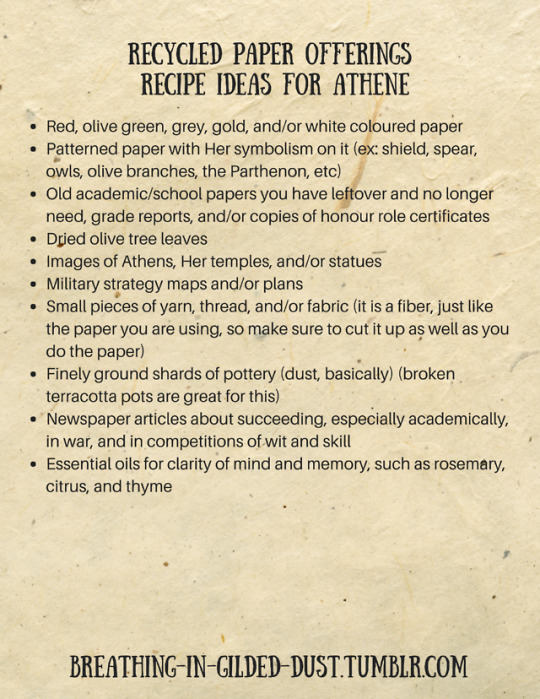




Alright, Tumblr is finally working. Here is part one of my recipes for the 12 Olympians + Hestia. In this post, I have included:
Ares
Apollon
Aphrodite
Artemis
Demeter
Athene
Hephaistos
Hera
Hermes
Dionysos
113 notes
·
View notes
Photo


This is my how-to recipe for making recycled paper, specifically for when I make them for offerings to the Theoi. I would like to give a big thank you to @floralwaterwitch for the inspiration with their own posts and how-to on making it!
Feel free to use this, share, it etc. Do not remove my caption or modify the images, please!
I also have 13 recipes I am trying to post, for each of the Olympians, and Hestia. I am making more, so don’t worry if you’re looking for one and don’t see it! I have a few others on my list currently.
286 notes
·
View notes
Text
How to Pray, Praise, and Worship the Theoi
As someone who struggled to find resources that weren’t entirely one sided and hard to understand, I believe this post is in order! It explains how to petition to, (in other words, pray to) the Theoi concerning both everyday matters and big events in your life, as well as how to praise them and some general worship tips. I hope this helps some of you get started!
P.S. This is from a reconstructionist point of view, so if you’re not very traditional, then this post may not hold everything you’re looking for!
Prayer
Unlike what I first thought whenever I began doing research into Hellenismos, praying is not simply talking to a Theos, or even praising them. There is definitely a place for that in Hellenismos, but prayer typically means to ask for help in a matter that the Theos has a connection to. So when I talk about prayer, this is what I refer to. For example, asking Aphrodite for help in your love life is praying to Her.
Prayers are usually said while an offering is being given, whether that be after a hymn, libation, etc. Or it can happen in a moment where you can call upon the Theos of your choice and say something such as “if I have ever brought offerings to you, hear my prayer”. Prayers are very loose and there aren’t necessarily rules for petitioning the gods, just general standards. For example, don’t outright demand something from the Theoi without an offering or something similar. Be respectful, and know that you are asking for something, not taking money out of the bank. If the gods will it, it shall happen
Whenever I want to pray for something, I sing a hymn. Sometimes these are ones I write myself,or they come from the Homeric or Orphic hymns. I’ll be talking more about praising the Theoi in a little bit, so I won’t go into details, but incorporating your prayer into a hymn is very easy to do, and hymns often make a good lead-up offering. Singing a hymn, no matter how awful you think your singing voice is, is a performance and a gift to the Theoi. Sing, be proud, and lift your words to the heavens. They will appreciate all you give as long as it comes from your heart.
If you cannot or will not sing for any reason, giving an offering may be your best choice. Poetry, artwork, food, libations, incense/candles (mainly for Ouranic Theoi) and anything else you wish to give, such as time, are perfectly acceptable offerings. If you’re curious as to how one goes about conducting a traditional Ouranic offering, please visit this blog post. I am still writing one to match the khthonic side of things. My apologies!
In times of need or when you have very little time but desperately wish for the aid of the Theoi, you can petition to the gods without an offering. I have done this either with a mention of a previous offering, or an oath to give them a specific offering if they helped me. Here’s an example for both instances:
“Wise Athene, if I have ever pleased you with my offerings, answer my prayer, great goddess!”
“I swear upon the life which I love to make you an offering, Athene, if you aid me and answer my prayer!”
You can then say your prayer after making this plea or beforehand by using something similar. I think the more heartfelt and honest the prayer, the better. I have a few daily prayers I use and I try to really feel them, since I’ll be using them very often. If a certain prayer clicks with you, I say use it.
Praise
Praising the Theoi is a major part of Hellenismos, and as such, there are tons of ways you can shower the gods with adoration and love. As aforementioned, hymns and offerings are both excellent ways to do so.
Hymns, in the Hellenic sense, are beautiful poem-like songs we can sing (or say) to build kharis with the Theoi. Kharis is the grace, the love, and the beauty shared between a mortal and a god. It is the relationship.
The Homeric and Orphic hymns are obviously very well-known, but they are by no means the only or the best hymns out there. Ones made by yourself or other Hellenists are also wonderful. @hymnstothetheoi has a collection of hymns on their tumblr blog, which I recommend for anyone interested in learning more. @baringtheaegis om tumblr has a wonderful post on how one could go about creating a hymn based off of the Orphic hymn to Pan. This is similar to how I personally write my hymns.
Feel free to only use the Homeric and Orphic pieces, but you don’t need to by any means. I love the old style of them and the connection I feel to the Ancients, but I make my own for personal and public use as well. During rituals, using the old hymns seems special, so I do that. Here is a link to a pdf download of the Homeric hymns (as soon as you click on it it will begin downloading, just so you’re aware). I haven’t found a good resource for the Orphic hymns as of yet, but Theoi.com definitely has a nice collection in their library.
Other ways to praise the Theoi include celebrating some of their festivals, dedicating time to them (doing something they hold influence over, ex: archery for Artemis and/or Apollo), or even keeping an e-shrine or playlist you made for them. People with disabilities, illnesses etc. often do things such as simply spend time thinking about them or creating aesthetic posts. These are wonderful alternatives to energy-draining activities such as rituals.
Worship
Prayer and praise both tie into worship. The only reason I didn’t include praise within the worship heading is because I wanted to touch more on the ritual aspect of Hellenismos. I barely knew anything about rituals as a beginner simply because no one had any resources. After finding Elani’s blog, that changed of course, and I began to understand what rituals were and how to do them. A big thank you to her for all of the information and resources, I have no idea how I would have learned everything without her.
In ancient Hellas, there were rituals, and they were usually public. They were very important to the city that held these rituals, so I see them as vital in my personal practice. Rituals are not for everyone, of course, but I love them. There were very repetitious steps involved in rituals, so once you grasp the concept, it comes naturally and is easy to follow.
A procession would take place first, sometimes from outside the city walls, or from an important place. To mimic this procession, many modern Hellenists take a walk outside or around their homes to put themselves in the ritual mindset. It’s a small thing that helps in the long run.
After the procession, the people cleanse themselves and the space, and of course the offering. Temples had an altar set up outside where people would gather to watch and make prayers as the offering (usually an animal sacrifice) was made.
Barley was scattered to cleanse the altar space, people washed themselves with khernips, and this was called Katharmos. In other words, it was a time for cleansing away miasma. They would also circle the altar with khernips to cleanse it as well.
After this had been done, prayers, hymns, and other related things were sung and said. They would make their sacrifice, and then hold a feast using the meat of the animal they had sacrificed (unless this was a cthonic ritual, in which case nothing sacriificed would be ingested). In modern times, people may give up something such as a bottle of wine or a meal, and then feast with what they give up.
408 notes
·
View notes
